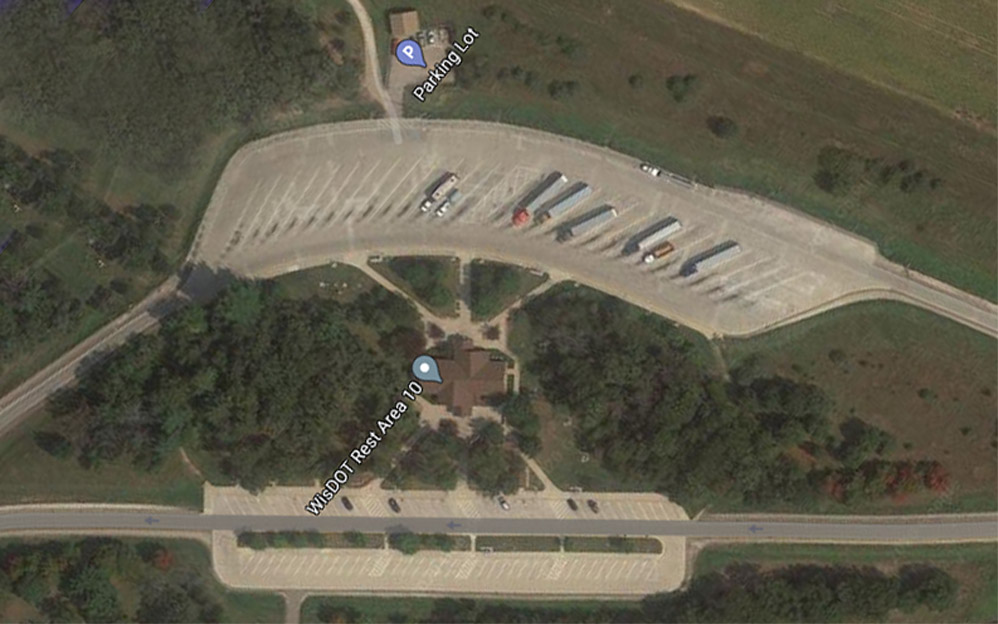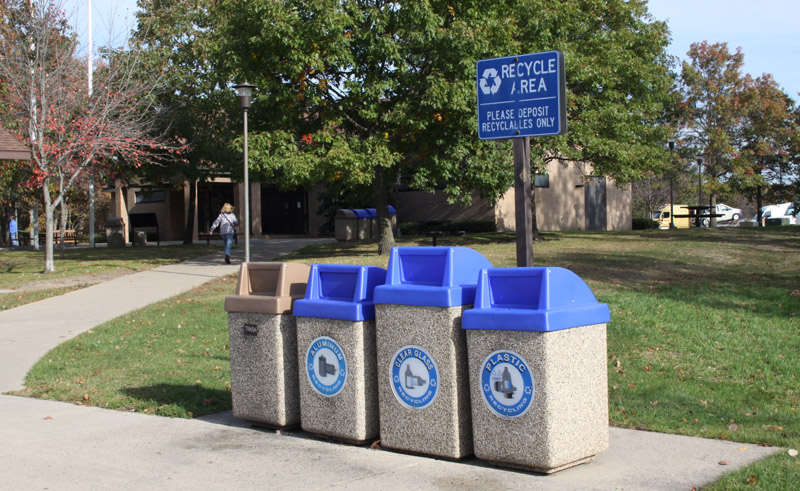
Mauston - Rest Stop
10
The little town of Mauston is located in central Wisconsin, just north and west of the Dells area. This is an area of rolling hills, small farms, and little in the way of urban blight. Nearby are several state parks, some bluffs,and the Camp Douglas military reserve base. This is in the geologically interesting driftless area of Wisconsin, where the glaciers did not penetrate during any of the several ice ages during which they advanced. This left many interesting cliffs, spires, and rock formations, including the Dells themselves.
This stop is the twin of the Lyndon Station rest area, which serves traffic in the opposite direction. These are of a fairly uniform design, unlike some of the showpiece stops at state lines or tourist areas. Because of the traffic flow and the proximity of the Dells and so many other tourist areas here, this stop does display some of the old fashioned tourist literature that used to figure so prominently at rest areas.
In common with all Wisconsin rest areas, there are a number of recycling stations to get rid of whatever roadside refuse has collected in your car during you travels. Also provided is drinking water, a phone, rest rooms, weather forecasts, assorted historic markers, and picnic areas. The DMV makes an effort to lure travelers to these stops and insure they are not out on the road with no break. They tend to be located approximately 50 - 100 miles apart, allowing for breaks to be taken every hour or so.
Lots of shade trees make this a real nice place to stop in the summer, and even in the spring and fall. The entryway is shaded and with the trees and benches is a bit reminiscent of a front porch. It can act as a nice reminder that even on the freeway, you are out in the Wisconsin countryside. Winters in Wisconsin its everyone for themselves, though even then, rest areas are a welcome relief from the fatigue of driving, a nice stop for snacks, and perhaps a place to pick up some local color.
This rest area was updated, and the new pavilion built in 1992.The old pavilion, from 1964, which was basically just a couple restrooms in a field-stone cabin, is still standing and acts as a storage shed and utility area. It sits off in a wooded area with its propane tank. Most of these old structures had been knocked down for landscaping when these sites were updated, so it is one of only a few remaining.
In addition to the picnic areas, shade trees, landscaping, and parking areas, the grounds contain a pet walking and exercise area. This can be handy for dogs and other pets that are cooped up in a car and need to use the facilities as much as any long suffering human. The pet area is located far away from the picnic area for obvious reasons.
- Southeast of Mauston, Juneau County
- Mile marker 75
- GPS coordinates: N 43° 44.790' W 89° 56.606'
Amenities
- 76 car/25 truck parking stalls
- Men’s and women’s restrooms
- Family/assisted restroom
- Handicapped accessible
- Diaper changing facilities
- Drinking water
- Vending machines
- Travel/weather information
- Telephones plus TTY
- Picnic area and tables
- Pet exercise area
- Recycling areas
Features
- Rest area opened in 1964. New building and enlarged site opened in 1992.
- Truck Parking Information Management System (TPIMS)
- "The Sand Counties - Aldo Leopold Territory" Historical Marker located on site.
Parking
For trucks, parking is pull in and pull out, so no backing is required. A total of 76 cars and 25 trucks are supported. Car parking is in front of the pavilion, near the freeway. Truck parking is in the back, offering a bit more privacy for drivers taking their required rest breaks.
The areas by the pavilion, near each of the parking sections, offers places to sit, and its own entrance. Also a regular feature of the truck lots, is the presence of a cell phone tower.
Camping is not permitted, as it is said to interfere with the stated purpose of these rest areas. Hunting (no surprise) and geocaching are also not permitted. While the DOT wants us to be comfortable and find these areas pleasant, they are not campgrounds or recreation areas.
For the purposes of the DOT, you are camping if you unhitch a trailer, pop out an awning, or extend a slide out. visitors are also not allowed to set their outdoor furniture up or to pitch tents.
Picnic/Grounds
Picnic tables are of steel and heavy plastic,designed, like most things here, for long term heavy use. The are permanently mounted on concrete slabs to deter theft, and insure that there will no mud, dirt, or bothersome insects making them unusable.
The concrete mountings make it impossible to relocate these tables. In addition to deterring theft, this prevents visitors from moving these tables out to the parking areas, ramps, or other potentially dangerous locations.
Special
The DOT is making an effort to make all rest areas places of interest as well as places of rest. To advance these efforts, in addition to the picnic areas, and general condition of the grounds, markers are being erected.
Some markers recognize historic events, or people, while others commemorate service, or call attention to unique geologic properties of the local area.
Two such markers grace this area. One recognizes that this is near where well known conservationist Aldo Leopold restored the land on an 80 acre farm that had exhausted itself.
This was back in 1935, when there really was nothing like today's conservation movement, and people did not really understand the self healing power of the land.
The other marker is a bit more general, and recognizes the service of Wisconsin veterans, in all past conflicts, and calls attention to the designation of this section of highway as being the Wisconsin Veterans Memorial Highway. It is a marker shared by a number of other rest stops scattered along this specially designated stretch of highway.
Pavilion
The massiveness of the structure, and its lack of conventional windows, makes it nearly immune to wear, weather, vandalism, and also helps it serve as a massive heat sink to ease the burden of heating and cooling.
There are two public entrances, a front one for automobile passengers, and a rear one to serve truckers. Both are enclosed by a substantial brick shelter, almost like a large porch, and both have double sets of glass doors. In addition to benches and walkways, both entrances are flanked by the ubiquitous recycle stations which are scattered all over the site. The state is serious about discouraging litter.
The back looks much the same as the front, except for the air conditioning units, and the slanted approach to the entrance. The side has a large steel door for deliveries, maintenance crews, and repair teams. It gives access to the building systems,a swell as an office and utiliity areas.
Interior
The main area is windowless, except for the double door entryway. Again, this is geared towards ease of maintenance, and resistance to vandalism. It also makes the building easier to heat and cool. Also assisting with this is the high gabled ceiling with fans that allow for bring warm air down in the winter, and leaving it rise in the summer.
These rest areas never close, are often isolated, and lead hard lives. Regular maintenance crews do come in to clean,and do routine repairs, but the areas are not generally continuously staffed, though they are regularly patrolled by local law enforcement.
This is one of the few remaining rest areas that are still stocked with tourist literature. A couple of racks offer an assortment of guides, advertisements,and booklets catering to the tourist. This is largely due to this particular stop being situated in one of the more tourist oriented parts of the state. Much of this type of information it now typically accessed through cell phones, tablets, or laptop computers, now in common use among travelers. Also a rare sight these days is a payphone, something featured at most Wisconsin rest areas. Bulletin boards keep travelers informed about local issues and laws. A drinking fountain (Closed curing Covid) and tap provide potable water.
Keeping everything clean is a big priority at these stops. Both sets of restrooms are provided with changing stations. The only windows are high set, frosted, and small for ventilation and a bit of natural lighting during the day.rest room facilities are fully disabled accessible, as in all public buildings.
Other than the restrooms, some vending machines,phone, drinking water, and a main hall, there isn't much else to the interior here, outside of a maintenance area in which the public is not permitted. Commercial activity is not allowed here.
Selections vary, depending upon location, but generally drink machines outnumber snack machines. Machines take bills or change, with some even taking charge cards.
Like most things on the road, the prices are a bit high. Yet the profits generally go to support the crews that clean and stock the areas. Wisconsin has a deal with RFW to provide disabled workers to service the rest stops. It's a nice way to get workers for these isolated areas.